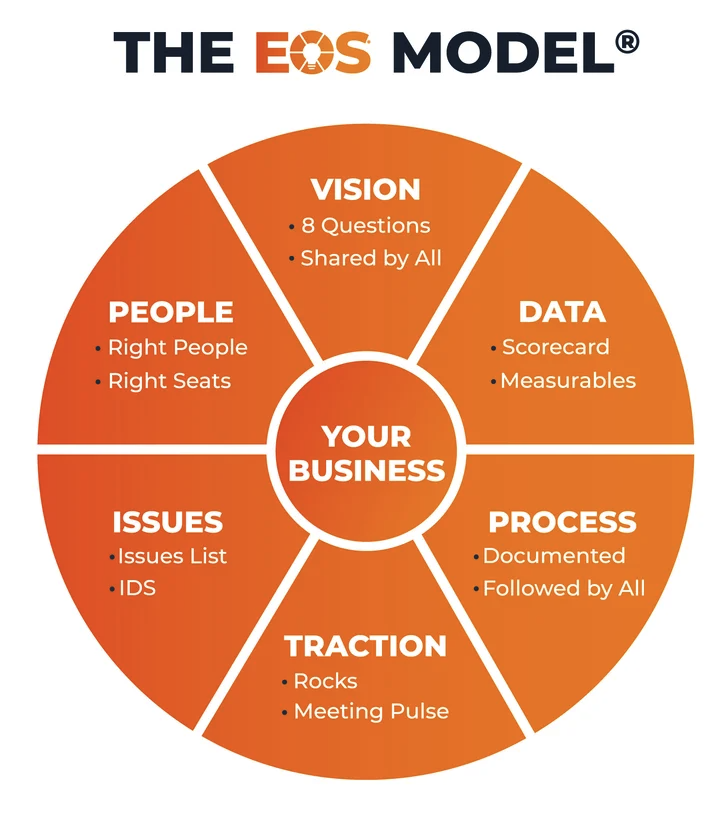Implementing EOS: Driving Clarity, Culture, and Results

When I applied for the Certified Chamber Executive (CCE) designation, one of the requirements was to complete a project that captured something I had personally executed which directly benefited my organization or community. For my project, I chose to capture and reflect on my decision to implement the Entrepreneurial Operating System (EOS) as the operating framework for the Chamber. I began this work while serving as Vice President of Operations, first by selling our then-CEO on the model, and later by guiding the implementation that has since become the backbone of how we operate.
What is EOS?
EOS is a business framework designed to help organizations achieve their vision by strengthening six key components: vision, people, data, issues, process, and traction. It provides simple tools and a shared language that drive clarity, accountability, and measurable results. While it is used in thousands of companies around the world, it has proven to be just as effective in nonprofits and chambers of commerce.
Source: EOS Worldwide
EOS helped us move from patterns of reaction to a rhythm of intentional strategy. Most importantly, it aligned our daily work with our mission to be the voice and resource for business in the region.
“EOS helped move our organization from reactive operations to intentional strategy. It has made me a better leader and our chamber a better partner to business.”
Why Utilize EOS?
When I stepped into the CEO role, our Chamber was more than 100 years old. With that history came legacy systems, overlapping roles, and programs that were not fully aligned to our mission. Because I had already been part of implementing EOS as VP of Operations, I entered the CEO role with confidence that we had the right structure to modernize. EOS offered not just tools, but a way to hold ourselves accountable to the mission we were there to serve.
Culture Shift in Action
One of the biggest changes was creating an accountability chart that assigned every function to a seat rather to an individual personality. This clarity of role eliminated position creep and gave the team confidence about how their work connected to strategic goals. We also restructured into two vice president roles, guided hiring by core values, and introduced quarterly priorities called “rocks” and organizational scorecards.
The cultural shift has been profound. Conversations that were once reactive are now metric driven and solutions focused. Legacy programming that drained resources has been replaced with value-based membership benefits. Ownership over the role of membership is no longer siloed. It is a team wide responsibility with clear leadership guiding strategy.
“I have said before and I’ll say it again: Clarity, communication, and honest opportunities to pivot and grow are what make people their strongest.”
Metrics That Matter
The results speak for themselves. Our Net Promoter Score rose from 18 in March 2023 to 34 in 2025 pulse surveys, and members rated both events and networking in the “great” category. Engagement is also growing. Since April 2025, 20 members upgraded their membership, increasing their spend by 68 percent to receive benefits that help them achieve their goals.
The team has experienced its own transformation as well. Our Employee Net Promoter Score is 20, a strong benchmark in the HR world, and quarterly goal completion rates improved from 40 percent to 70 percent in just over a year.
Implementing EOS was not without challenges. I have learned that high expectations only work when matched with clear structure. Letting go of distractions was difficult, but it created focus for every member of the team. Managing transitions when team members were not aligned was of course a challenge but anchoring to our core values and keeping scorecards front and center gave us confidence to keep moving forward.
“An important leadership lesson that I have had to learn is that hard conversations are not what hurt people. They are the very thing that prevents harm. EOS gave me the structure and language to make my conversations the most beneficial for everyone.”
What’s Next
EOS is now the backbone of how we operate. From onboarding new team members to refining scorecards and launching a new strategic plan, EOS continues to help us stay focused, aligned, and accountable.
For me personally, capturing this project was a reminder that clarity creates confidence for staff, for members, and for me as a leader. This project represents exactly what the CCE process is designed to capture: work that demonstrates impact, innovation, and lasting benefit for the organization and community you serve. For me, implementing EOS was not just a professional milestone, but a clear example of how structure and vision together can unlock possibility. It has been transformational, and it is only the beginning.
